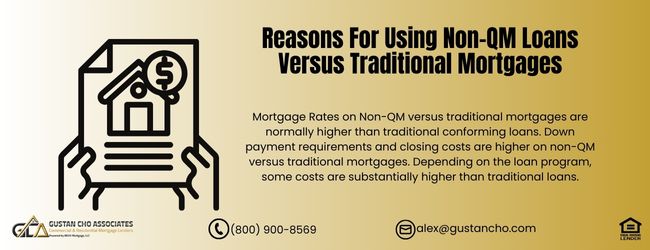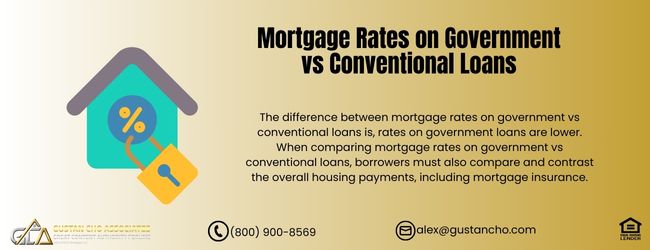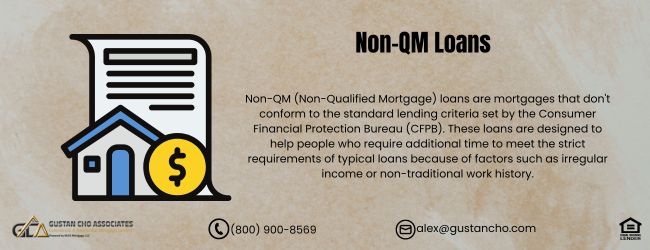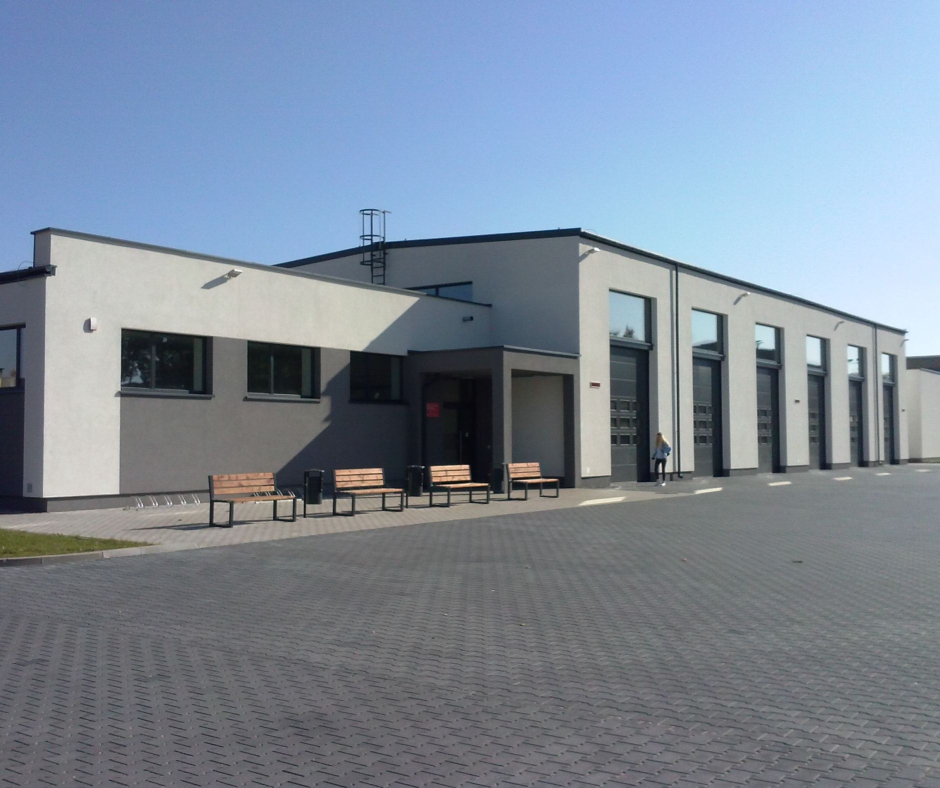Reasons For Using Non-QM Loans Versus Traditional Mortgages

In this blog, we will be covering the reasons for using non-QM loans versus traditional mortgages for home purchases. Non-QM loans are a wide field. Non-QM loans are non-Qualified mortgages which means these loans are non-conforming loans. Non-Qualified mortgages are portfolio loans. The CFPB rules and regulations has a separate set of guidelines on non-QM loans. However, non-QM loans still need to adhere to RESPA and residential mortgage regulations and guidelines on primary owner-occupant homes. In the following paragraphs, we will cover the reasons for using non-QM loans versus traditional mortgages. Non-QM loans are not just for borrowers with bad credit. There are many instances why higher credit profile borrowers with good credit and high net worth have reasons for using non-QM loans versus traditional mortgages. In the following paragraph, we will cover the reasons for using non-QM loans versus traditional mortgages.
What Are Non-QM Loans versus Traditional Mortgages?
There are countless reasons for using non-QM loans. Non-Qualified Mortgages also referred to as non-QM loans, are alternative mortgage loan programs that do not follow Qualified Mortgage guidelines of the Consumer Financial Protection Bureau (CFPB). Non-Qualified Mortgages do not necessarily follow CFPBs ability to repay (ATR) Qualified Mortgage Guidelines. Non-QM loans are portfolio loans.
By no means are non-QM loans hard money loans or high-risk loans for high-risk borrowers. Non-Qualified mortgage rates are based on credit scores, loan to value, type of property, and other risk factors just like traditional mortgage loans.
Click Here to apply for Non-Qm Loans
Lending Guidelines on NON- QM Loans versus Traditional Mortgages
Non-QM loans are portfolio loans. Portfolio loans mean lenders will keep the loan in their portfolio or sell it to private institutional investors. There is no set uniform agency mortgage guidelines on non-QM loans. Each individual non-QM mortgage lender sets its own non-QM lending requirements.
What Are The Main Reasons For Using Non-QM Loans versus Traditional Mortgages For Borrowers?
Non-QM lenders can make exceptions when it comes to the guidelines of each individual borrower. In general, non-QM mortgage lenders use the common sense principle applies approach on a case-by-case basis for each individual mortgage borrower. A non-QM lender can make exceptions such as exceeding the debt-to-income ratio to giving exceptions on credit tradelines or some other guideline changes.
Mortgage Rates on Non-QM Versus Traditional Mortgages
Mortgage Rates on Non-QM versus traditional mortgages are normally higher than traditional conforming loans. Down payment requirements and closing costs are higher on non-QM versus traditional mortgages. Mortgage Rates on Non-QM versus traditional mortgages are higher than government and conforming loans. Depending on the loan program, some costs are substantially higher than traditional loans.
What Are The Fees and Costs of Non-QM Versus Traditional Mortgages?
Mortgage rates on non-QM versus traditional mortgages are typically 2.0% higher. Depending on the individual mortgage loan program, non-QM mortgage lenders may also charge discount points on non-QM loans. DSCR loans and no-doc loans often have higher mortgage rates plus one to three discount points as a premium. In the following paragraphs, we will cover the various types of non-QM mortgage loan programs for owner-occupant primary homes, second homes, and investment properties. Click Here to apply for Traditional Mortgage Loans
Popular Non-QM Mortgage Loan Programs
Non-QM loans are becoming increasingly popular. Non-QM loans benefit borrowers who either cannot qualify for traditional mortgages or exceed the maximum loan limit of conforming loans. Non-QM loans are known for using non-traditional income as qualified income. The 12 months of bank statement deposit loans for self-employed borrowers do not require income docs. Lenders will go off the average of the past 12 months of bank statement deposits.
Reasons for using non-QM loans are due to the various no-income documentation loan programs. Other reasons for using non-QM loans are due to alternative mortgage loan options such as no-doc loans, DSCR mortgage loans, stated-income loans, asset-depletion, and 1099 income-only mortgage loans. Non-QM Mortgage Brokers has hundreds of wholesale mortgage loan options on non-QM and alternative financing loan options for owner-occupant primary homes, second homes, and investment properties. Other reasons for using non-QM loans is the mortgage process is simple. Most non-QM loans close in 30 days or less. Non-QM Mortgage Lenders has dozens non-QM options.
This blog on the reasons for using non-QM loans versus traditional mortgages was updated and published on September 3rd, 2024..
Frequently Asked Questions on Non-QM loans versus Traditional Mortgages
Non-Qualified Mortgage (Non-QM) loans have certain advantages over traditional mortgages, and here are the frequently asked questions (FAQs) with that explanation:
What are Non-QM Loans versus Traditional Mortgages?
Answer: A Non-QM loan refers to a mortgage that falls outside the terms of a ‘Qualified Mortgage’ or QM as defined by the Consumer Financial Protection Bureau. Wholesale lenders usually introduce non-QM loans in the markets with easy underwriting features. Non-QM loans are for people with such particular needs as self-employment, unstable income, recent bankruptcy or foreclosure, late payments in the past 12 months, and bad credits in the past years.
Is a Non-QM loan the Same as a Conventional Mortgage?
Answer: Non-QM loans differ from traditional mortgages in several ways:
- Discretionary policies: Non-QM Loans are less “disciplined,” and “conventional guidelines” regarding subprime criteria are not strictly exercised.
- The following summarizes the differences between non-QM loans and traditional mortgages (government and conventional loans):
- Underwriting Flexibility: Due to changes in risk management in the mortgage industry, non-QM loans incorporate more relaxed underwriting requirements.
- This includes using other forms of income documentation.
- For example, instead of W-2 forms, bank statement deposits are used.
Credit Requirements on Non-QM Loans versus Traditional Mortgages
Non-QM loans can be approved even for people with recent bad credit rating events. Examples include foreclosures and bankruptcies, which would automatically disqualify them from conventional mortgages.
Monetary:
- Non-QM loans are unlike the other types of mortgages.
- Non-QM loans allow higher DTI than what is allowable for other types of mortgages is usually permissible.
- Hence wearing more debt.
- More debt is acceptable with non-QM loans.
Interest Rates: Traditional mortgages have lower interest rates than non-QM loans. This is because the lender has to bear the inherent risks.
Who can be classified as an ideal borrower for non-QM loans versus Traditional Mortgages?
Who is a good candidate for a non-QM loans versus Traditional Mortgages?
Answer: Non-QM loans are good for borrowers that fall into these categories:
Who is this particular lender usually dealing with, and who would seek Non-QM loans versus Traditional Mortgages?
- Self-employed persons who find it hard to provide proof of normal income.
Who are the greatest applicants for non-QM loans versus Traditional Mortgages?
- Some of these people do not earn a steady or traditional income.
- Examples are freelancers, diggers, and so on.
- Borrowers with a recent foreclosure, clients with low credit scores, or those who have recently run into bad credit, including bankruptcy, and so on.
- People with a DTI ratio that exceeds acceptable levels as far as fixed mortgages are concerned. …
Are investors and overseas people who do not conform to the regular lending norms?
Enumerate the benefits of non-QM loans versus Traditional Mortgages.
Answer:
- Flexibility: If the borrower’s finances are nontraditional, the underwriter may not impose additional restrictions on the underwriting standards for such borrowers.
- Clients may qualify using anything but pay stubs or verbal income verification, such as bank statements or other financial means.
Accessibility: Non-QM loans could be more available for borrowers who do not meet the criteria for conventional mortgages. This is because of their credit problems, income instability, or other reasons.
Rehabilitation: Unlike other types of loans, non-QM loans may be usually issued with outlawed and unfavorable characteristics. Eventually, expropriate assets to pay off the debt can be structured according to the borrower’s desires, such as interest-only with no amortization and shorter loans.
Non-QM loans have so many advantages
Answer:
- Higher than normal percentage levels.
- Non-QM loans are often exposed to higher interest levels than ordinary mortgage loans.
- This is because non-QM loans are alternative forms of financing with lenient guidelines.
Down Payment on Non-QM Loans versus Traditional Mortgages
Non-QM loans require higher down payments to cover 10% to 30% risk.
Not Offered By All Lenders
Not all lenders offer non-QM loans. Limited choices may be available based on the borrower’s location or financial status.
Additional Charge on Non-QM Loans versus Traditional Mortgages
Extra fees above the salient charges are obvious in most mainstream lending products, including origination fees, which can be seen in non-QM loans.
How does the interest rate charged on non-QM loans versus traditional mortgages?
Answer: Non-QM loans charge a higher interest rate than normal mortgage loans. Normal mortgage lenders of traditional conforming loans usually have less risk as borrowers are scrutinized to ascertain their likelihood of loan repayment. Borrowers with less stable incomes and finances will likely seek more appealing non-QM loans. This is because of the lenient policies, which expose the lenders to greater risks. However, the degree of difference depends on other related factors like the type of loan, the actual score, and the institution that extends the loan.
Is it possible to obtain a conventional mortgage after a non-qm loan?
Answer: Yes, it is possible to refinance from a non-QM loan to a traditional mortgage. Non-QM Loans are often considered a stop-gap by borrowers, who then refinance to conventional loans once they are able to improve things like credit scores, job stability, or DTI ratio. These may include lower interest rates and more favorable terms.
Non-QM loans – what types are available?
Answer: Common types of non-QM loans include the following: They do not require self-employment documents. However, only personal bank statements are given.
- Bank Statement Loans: These loans target the self-employed, and they confirm income by replacing W2s and tax returns with bank statements.
- Interest loans: Borrowers only pay interest for a predetermined time, and after that, both interest and the principal amount are repaid.
- Asset depletion loans: These loans are for borrowers with large assets yet little income and are based on assets rather than income.
- DSCR Loans (Debt-Service Coverage Ratio): Typical among real estate investors, the loans are underwritten based on the property’s income potential rather than the borrower’s income.
- No-Ratio Loans: These loans do not require income from the applicant when underwriting them. The application is based only on the applicant’s credit and assets.
- P & L Statement Non-QM Loans
Are Non-QM Loans versus Traditional Mortgages worth it?
Answer: Non-QM mortgages can be a safe bet if they are used properly and comprehended thoroughly by the borrower. They are more specifically targeted towards individual users rather than sub-prime loans in the past, which embraced widespread approaches to risk for the benefit of a broader population. However, there are risks of high prices for the borrowers, which are important to discuss beforehand.
Who will lend non-QM loans versus Traditional Mortgages?
Answer: A Non-QM loan qualification checklist usually requires that you do the following:
- Provide alternative income verification such as bank statements or asset documentation.
- Credit criteria usually apply but are less rigorous than those of traditional mortgages.
- A sufficient down payment can range from 10% to as high as 30%.
- This depends on the type of loan and individual lender.
- Show capacity to service the loan.
- Conventional fashions may render one unable to do so based on income or credit history.
How do non-QM loans versus traditional mortgages differ in terms of documentation requirements?
Answer: In these cases, non-QM loans have been laid. You should also ask for four alternative documentation types that deviate from conventional or orthodox as embraced by regular mortgages.
For instance, Bank Statements: In lieu of W-2s or tax returns, you may submit a year to two years’ worth of bank statements showing income instead.
Asset Statements: Asset depletion loans may require detailed asset statements showing your available assets.
Property Income: For DSCR loans, the documentation focuses on the rental income that the property earns rather than one’s income.
Do you have any restrictions on using non-QM loans for investment properties?
Answer: Yes, real estate investors commonly use non-QM loans. Some non-QM loans, such as DSCR loans, support investment property financing. This means the loans are secured based on property earnings, and borrowing one’s income is not required.
What’s the difference between the down payment required for non-QM Loans versus Traditional Mortgages?
Answer:
Non-QM Loans: Typical down payment percentages may vary from one lender to another from about 10% to 30%, with some factors such as loan type and borrower’s credit profile being considered.
Traditional Mortgages: A conventional residential mortgage offers 3% and 5% down payment options, while a 20% down payment is necessary to eliminate the set PMI costs. An FHA home loan can require as little as 3.5% down with a credit score equal to or greater than 580.
What do I need to consider before committing to Non-QM Loans versus Traditional Mortgages?
Answer: Prior to making a non-QM loan, you should pay attention to Interest Rates and Costs. Compared to traditional mortgages, non-QM loans are expensive in terms of interest rates and associated fees.
What are the qualities about you or your circumstances that would Purpose? Examine whether your circumstances are likely short term and whether you intend to convert into a traditional mortgage.”
Repayment Terms: Try to control the repayment structure, especially if an interest-only or additional-rate loan is chosen.
Risk Tolerance: Be sure you are ready to bear the additional cost, with an expectation of non-QM loans and associated risks.”
What are the other alternatives to non-QM loans versus Traditional Mortgages?
Answer: The following are the possibilities if you meet the requirements for the fixed-rate loan:
Conventional Loans: Conventional loans require a minimum credit score 620, a debt-to-income ratio of up to 50%, a 3% to 20% down payment, and qualified income.
FHA Loans have a higher level of risk, made possible by the low DTI and credit score requirements.
VA Loans. Guarantees are offered for active military personnel and veterans; no down payment is required.
USDA Loans. Offer basic strapped-down loan options for use in the country’s outlying areas.
Portfolio Loans are loans not sold to the secondary market but retained by the lenders themselves, allowing more room for variance.
The seller takes the role of the bank and finances the buyer directly.
These FAQs should clarify the differences between non-QM loans and traditional mortgages, enabling you to appreciate which is best for your financial situation. Click Here to apply for mortgage with low credit score







Responses